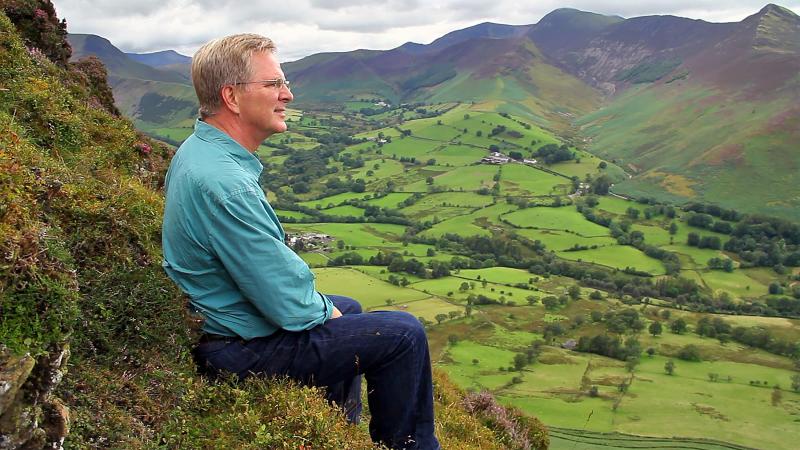Rick Steves’ Europe: England’s Lake District: Land of great hikes and poets
Appears in the Online Edition, April 2022.
In England’s Lake District, nature rules and humanity keeps a wide-eyed but low profile. At just about 30 miles long and 30 miles wide, the region is a lush, green playground for hikers and poets alike. William Wordsworth’s poems still shiver in its trees and ripple on its ponds. There’s a walking-stick charm about the way nature and culture mix here. Walking along a windblown ridge or climbing over a rock fence to look into the eyes of a ragamuffin sheep, even tenderfeet get a chance to feel outdoorsy.
I’ve come here to enjoy some natural thrills and renew my poetic license. I focus on the northern lake of Derwentwater, with the nearby town of Keswick as my home base. It was an important mining center through the Middle Ages, but slate, copper, and lead gave way to Romantic poets and tree-hugging tourists in the 19th century. Keswick’s fine Victorian buildings recall those Romantic days when city slickers first learned about “communing with nature.” And its thriving market, which fills the pedestrianized town center and feels more tuned into the needs of residents than tourists, gives the visitor a chance to feel the pulse of the local community.
A bald and bold hill called Catbells towers over Derwentwater. Often over the years, from a boat on the lake, I’ve looked enviously at hikers: tiny stick figures working their way up the ridge to that enticing 1,500-foot summit. Locals call these distant figures silhouetted against the sky at the summit “crag rats.” With a free afternoon for a hike, I’m excited to finally become a crag rat myself. But the blustery weather conspires to keep me in. My B&B host loans me a better coat and eggs me on, saying, “The wind will blow the cobwebs out.”
I venture up the ridge, leaning into the wind, passing the comedic baaing of sheep. Finally — savoring that “king of the mountain” feeling — I stand all alone on the top of Catbells and stoke someone else’s crag-rat envy.
The blustery weather reminds me of what I’ve learned about Britain: Don’t wait for it to get better. Dress in layers and expect rain mixed with “bright spells.” Drizzly days can be followed by long and delightful evenings. You can usually find convivial and atmospheric shelter at strategically placed pubs. And these days there are two kinds of pubs: drinking pubs and eating pubs. Among those whose focus is eating, gastropubs can earn a reputation for some of the best meals in a town or even a region.
And, oh, the joy of a pub after a good hike. When my face is weather-stung and my legs ache happily with accomplishment, a pub’s ambience sparkles even brighter and a good pint of beer is even more refreshing. Keswick’s Dog and Gun pub, where “well-behaved dogs are welcome,” is predictably full of hiking-partner pups. You can always pal up to an English pooch — I find they’re happy to introduce you to their masters.
In northern England, summer evenings come with a couple hours of light after dinner. Good maps locate historic roadside attractions worth a quick drive from bases like Keswick, and while these places can be noisy by day (and frustrating for drivers looking for a place to park), they are tranquil and all yours after dinner. For me, a twilight visit to these places is a wonderful way to cap a nice pub meal.
For example, after my pub grub in Keswick, I drive three miles east to the Castlerigg Stone Circle. Drenched in beauty, it stands like a mini Stonehenge. The majority of England’s stone circles are here in the northern region of Cumbria. Castlerigg is one of the best and oldest in Britain. The circle, 90 feet across and 5,000 years old, has 38 stones mysteriously laid out on an axis between the two tallest peaks on the horizon. They most likely served as a celestial calendar for ritual celebrations.
I wander through this stone circle and imagine it in megalithic times — alive with people as ancient as King Tut, filling the clearing in spring to celebrate fertility, in late summer to commemorate the harvest, and in winter to mark the solstice and the coming renewal of light. My sunset visit comes with solitude and maximum goose pimples.
Lingering in the Lake District, I can share my appreciation of nature with the crag rats, the poets, and the druids. While Cumbria’s charms are subtle, its rewards are great. Hiking along a ridge in the footsteps of Wordsworth or pondering my own private Stonehenge, I feel recharged, inspired ... and ready to write a poem.
(Rick Steves (www.ricksteves.com) writes European guidebooks, hosts travel shows on public TV and radio, and organizes European tours. This article was adapted from his new book, For the Love of Europe. You can email Rick at [email protected] and follow his blog on Facebook.)

